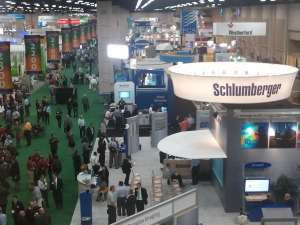Diffractions, Dust, and sub-Hertz imaging
/ Even the keenest geophysicist (and we are the keenest geophysicists) had to miss 96 presentations today. The first afternoon of talks comprised an impressive 104 talks in 13 sessions. If only 10% of talks are great, you might see one, and you would miss at least nine. Fortunately there are two of us, so we double our chances. These are our highlights.
Even the keenest geophysicist (and we are the keenest geophysicists) had to miss 96 presentations today. The first afternoon of talks comprised an impressive 104 talks in 13 sessions. If only 10% of talks are great, you might see one, and you would miss at least nine. Fortunately there are two of us, so we double our chances. These are our highlights.
Will Burnett, UT Austin
Diffractions, usually thought of as noise, emanate predominantly from faults and discontinuities. Will wants not to eliminate them but to use them as a complementary signal to boost imaging. His talk on diffraction velocity analysis described how, instead of picking an exact velocity model, a range of velocities are used to compute independent test images of diffraction events. Because the apex of a diffraction is the same no matter what velocity is applied, a stack of test images results in a concentration of the diffractor at the apex; the remaining events are stacked out. Blending this image with a reflection processed seismic yields a more vivid image. Also, this work was done using Madagascar... yay, open source!
 Kris Pister, Dust Networks
Kris Pister, Dust Networks
The power of mobile devices is impressive, but Dust Networks can build an accelerometer with optical communication and a microcontroller in a 5 mm3 box. The autonomous sensors build a time-synchronized mesh protocol with channel-hopping (yeah, they do!), meaning you end up with an internet-like network that tolerates dead nodes and other failures. Now Dust build such networks of all kinds of sensors, of all sizes, in industrial applications, and surely will soon be appearing in a wellbore or seismic array near you. One to watch.
Rebecca Saltzer, ExxonMobil
Easily the most enthusiastic presentation of the day was a rip-roaring tale from Wyoming. ExxonMobil buried fifty-five low-frequency Guralp CMG3T seismometers at their LaBarge oil and gas field. The devices were arranged in a line pointing towards the Pacific, to ensure a good source of earthquakes: the source for this grand experiment. The P-waves they intended to image with have a dominant frequency of about 1 Hz, hence the seismometers, with their 0.08 to 50 Hz bandwidth. And image they did: the result was a velocity model with 500 m vertical resolution and good agreement with a 1000-well velocity model.








 Except where noted, this content is licensed
Except where noted, this content is licensed